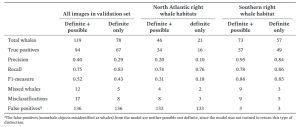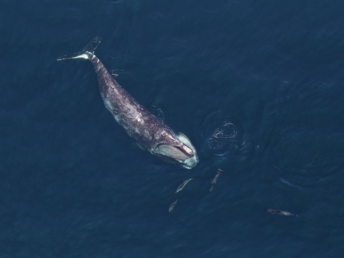Scientific paper on AI-powered smartWhales Space-Based Detection System published in Marine Mammal Science
Jul 16, 2025
Hatfield is pleased to announce a peer-reviewed paper introducing the Artificial Intelligence (AI) powered smartWhales Satellite-Based Detection System (SBDS), developed in collaboration with AltaML, Dr. Kim Davies from the University of New Brunswick, and Dr. Sean Brillant of the Canadian Wildlife Federation.
Funded under the Canadian Space Agency smartEarth initiative, this innovative system uses AI and satellite imagery to enhance whale detection, importantly contributing to conservation efforts for the critically endangered North Atlantic Right Whale (NARW).
With fewer than 370 NARWs remaining, and fewer than 70 of them being reproductively active, the smartWhales SBDS can play an important role in supporting conservation efforts in Canadian waters. Since 2021, the team has been evaluating Earth Observation (EO) satellite and AI technologies to detect these whales, and how it can support both management measures and marine science. This evaluation involved satellite imaging over two key foraging areas and employing convolutional neural networks for automated whale detection. The study created the largest dataset to date of satellite imagery of NARWs to develop and evaluate the SBDS and included satellite images of the similar-looking southern right whales to generate a larger training dataset.

Evaluating the SBDS using standard AI model performance metrics, the model shows significant technical promise for large-scale whale detection in Canadian waters. The overall evaluation discovered that AI models found 75% of the whales in the imagery. The results also highlight current challenges requiring further investigation and improvements, including the variability in model performance in NARW feeding areas in Canada and tropical southern right whale habitats.
This research underscores the potential of satellite imagery for marine conservation, especially in coastal areas, although challenges persist in northern regions. Technological advancements in high-resolution satellites and AI are driving increased interest in space-based detection of large marine mammals. Satellite technology enhances our understanding of animal behavior and migratory patterns on a large scale, and as these systems mature, they strengthen conservation efforts.
The smartWhales SBDS was financially supported by the Canadian Space Agency, Fisheries and Oceans Canada, and Transport Canada through the smartWhales Initiative.
View the full scientific publication, titled Semi-Automated Detection of Right Whales (Eubalaenaspp.) in Very High-Resolution Satellite Imagery.
Explore Hatfield’s Story Map highlighting the Canadian Space Agency’s smartWhales Initiative and the Space-Based Detection System (SBDS).
Photo: Catalog #1327 ‘Scoop’. Allison Henry/NOAA, under MMPA Permit #17335
